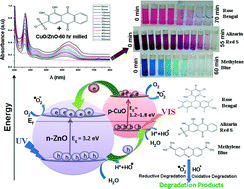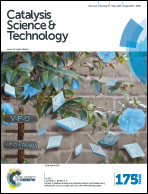Mesoporous CuO–ZnO p–n heterojunction based nanocomposites with high specific surface area for enhanced photocatalysis and electrochemical sensing†
Abstract
We report the synthesis and characterization of p-CuO/n-ZnO heterojunction nanocomposites and their application as a broad spectrum photocatalyst. The different systems were also found to serve significantly as an electrode material for electrochemical (amperometric) sensing of H2O2 and NH3 (in μM or ppm level). To investigate their photochemical activities, three dyes, viz. Alizarin Red S, Methylene Blue and Rose Bengal, were chosen. The 60 hour milled composite gave better photocatalytic activity than the unmilled and 30 hour milled systems due to homogeneous mixing, formation of appropriate p–n junction, significant lowering of particle size and enhanced specific surface area. The defect level of ZnO, which also increases with increasing milling duration, again helps in better catalytic performance by trapping the photogenerated electrons and holes and also by raising the valance band edge and thus narrowing the band gap. The 60 hour milled sample took 55, 60 and 70 minutes to degrade the ARS, MB and RB dyes, respectively, which are better than many previous reports. The degradation rate was 0.01931, 0.04663 and 0.02318 min−1 for the ARS, MB and RB dyes, respectively.


 Please wait while we load your content...
Please wait while we load your content...